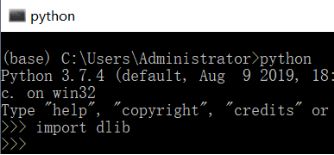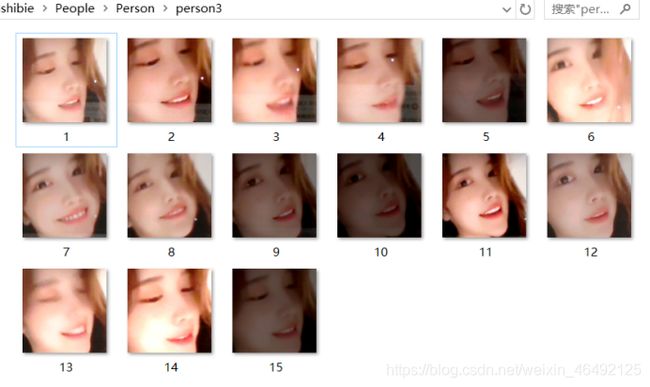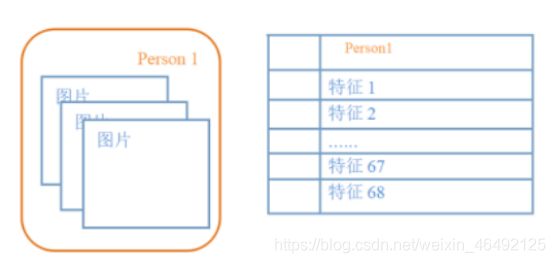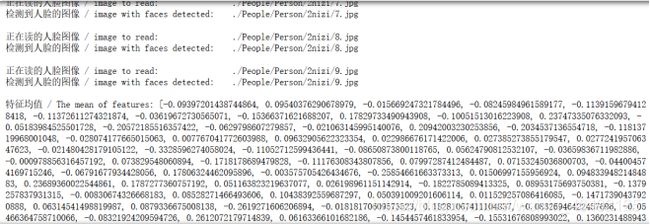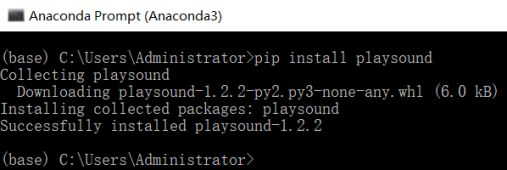基于dlib的人脸识别(jupyter notebook)
文章目录
- 一、构建数据集
-
- 1、安装dlib库
- 2、基于dlib库构建人脸特征数据集
- 二、特征检测
-
- 1、python+OpenCv+dlib实现人脸68个关键点检测并标注
- 2、获取特征点并保存数据:get_features
- 三、人脸识别
-
- 1、人物文件夹
- 2、Python读取wav音频文件
- 3、程序代码
假定该系统完成后将工作于学生宿舍门口,摄像头安装于门的猫眼处、或者门侧边墙上;对本宿舍的学生进行人脸识别(身份验证),通过验证就播放语音“欢迎光临!”(模拟开门),否则播放“抱歉,无法验证您的身份!”,同时用数据库记录来访者的身份、人脸图片和访问时间等信息。
一、构建数据集
1、安装dlib库
2、基于dlib库构建人脸特征数据集
采用的是视频流截图,在视频流中抓取人脸特征并保存为366x366大小的图片文件。
注意:在哪台笔记本识别,就要在那台笔记本做数据集采集。因为电脑的配置不同,在后面的训练中可能会出现不能识别或错误识别的情况,因此,尽量同一设备采取数据集和做人脸识别。
(1)程序代码
import cv2
import dlib
import os
import sys
import random
# 存储位置
output_dir = './People/Person/person4'
size = 366
if not os.path.exists(output_dir):
os.makedirs(output_dir)
# 改变图片的亮度与对比度
def relight(img, light=1, bias=0):
w = img.shape[1]
h = img.shape[0]
#image = []
for i in range(0,w):
for j in range(0,h):
for c in range(3):
tmp = int(img[j,i,c]*light + bias)
if tmp > 255:
tmp = 255
elif tmp < 0:
tmp = 0
img[j,i,c] = tmp
return img
#使用dlib自带的frontal_face_detector作为我们的特征提取器
detector = dlib.get_frontal_face_detector()
# 打开摄像头 参数为输入流,可以为摄像头或视频文件
camera = cv2.VideoCapture(0)
index = 1
while True:
if (index <= 15):#存储15张人脸特征图像
print('Being processed picture %s' % index)
# 从摄像头读取照片
success, img = camera.read()
# 转为灰度图片
gray_img = cv2.cvtColor(img, cv2.COLOR_BGR2GRAY)
# 使用detector进行人脸检测
dets = detector(gray_img, 1)
for i, d in enumerate(dets):
x1 = d.top() if d.top() > 0 else 0
y1 = d.bottom() if d.bottom() > 0 else 0
x2 = d.left() if d.left() > 0 else 0
y2 = d.right() if d.right() > 0 else 0
face = img[x1:y1,x2:y2]
# 调整图片的对比度与亮度, 对比度与亮度值都取随机数,这样能增加样本的多样性
face = relight(face, random.uniform(0.5, 1.5), random.randint(-50, 50))
face = cv2.resize(face, (size,size))
cv2.imshow('image', face)
cv2.imwrite(output_dir+'/'+str(index)+'.jpg', face)
index += 1
key = cv2.waitKey(30) & 0xff
if key == 27:
break
else:
print('Finished!')
# 释放摄像头 release camera
camera.release()
# 删除建立的窗口 delete all the windows
cv2.destroyAllWindows()
break
二、特征检测
1、python+OpenCv+dlib实现人脸68个关键点检测并标注
(1)利用Dlib官方训练好的模型“shape_predictor_68_face_landmarks.dat”进行68点标定,利用OpenCv进行图像化处理,在人脸上画出68个点,并标明序号。
(2)工作内容主要包含两大块
68点标定和OpenCv绘点。
(3)流程
A、调用dlib库来进行人脸识别,调用预测器
“shape_predictor_68_face_landmarks.dat”进行68点标定 ;
B、存入68个点坐标 ;
C、利用画圆函数cv2.circle 来画68个点 ;
D、利用输出字符串函数cv2.putText() 函数来画数字1-68。
(4)程序代码
# _*_ coding:utf-8 _*_
import numpy as np
import cv2
import dlib
detector = dlib.get_frontal_face_detector()
predictor = dlib.shape_predictor('./People/model/shape_predictor_68_face_landmarks.dat')
# cv2读取图像
img = cv2.imread("./People/1.png")
# 取灰度
img_gray = cv2.cvtColor(img, cv2.COLOR_RGB2GRAY)
# 人脸数rects
rects = detector(img_gray, 0)
for i in range(len(rects)):
landmarks = np.matrix([[p.x, p.y] for p in predictor(img,rects[i]).parts()])
for idx, point in enumerate(landmarks):
# 68点的坐标
pos = (point[0, 0], point[0, 1])
print(idx,pos)
# 利用cv2.circle给每个特征点画一个圈,共68个
cv2.circle(img, pos, 5, color=(0, 255, 0))
# 利用cv2.putText输出1-68
font = cv2.FONT_HERSHEY_SIMPLEX
cv2.putText(img, str(idx+1), pos, font, 0.8, (0, 0, 255), 1,cv2.LINE_AA)
cv2.namedWindow("img", 2)
cv2.imshow("img", img)
cv2.waitKey(0)
2、获取特征点并保存数据:get_features
根据数据集、模型—》训练—》68个特征数据—》写入csv
(1)程序代码
# 从人脸图像文件中提取人脸特征存入 CSV
# Features extraction from images and save into features_all.csv
# return_128d_features() 获取某张图像的128D特征
# compute_the_mean() 计算128D特征均值
from cv2 import cv2 as cv2
import os
import dlib
from skimage import io
import csv
import numpy as np
import pandas as pd
# 要读取人脸图像文件的路径
path_images_from_camera = "./People/Person/"
# Dlib 正向人脸检测器
detector = dlib.get_frontal_face_detector()
# Dlib 人脸预测器
predictor = dlib.shape_predictor('./People/model/shape_predictor_68_face_landmarks.dat')
# Dlib 人脸识别模型
# Face recognition model, the object maps human faces into 128D vectors
face_rec = dlib.face_recognition_model_v1("./People/model/dlib_face_recognition_resnet_model_v1.dat")
# 返回单张图像的 128D 特征
def return_128d_features(path_img):
img_rd = io.imread(path_img)
img_gray = cv2.cvtColor(img_rd, cv2.COLOR_BGR2RGB)
faces = detector(img_gray, 1)
print("%-40s %-20s" % ("检测到人脸的图像 / image with faces detected:", path_img), '\n')
# 因为有可能截下来的人脸再去检测,检测不出来人脸了
# 所以要确保是 检测到人脸的人脸图像 拿去算特征
if len(faces) != 0:
shape = predictor(img_gray, faces[0])
face_descriptor = face_rec.compute_face_descriptor(img_gray, shape)
else:
face_descriptor = 0
print("no face")
return face_descriptor
# 将文件夹中照片特征提取出来, 写入 CSV
def return_features_mean_personX(path_faces_personX):
features_list_personX = []
photos_list = os.listdir(path_faces_personX)
if photos_list:
for i in range(len(photos_list)):
# 调用return_128d_features()得到128d特征
print("%-40s %-20s" % ("正在读的人脸图像 / image to read:", path_faces_personX + "/" + photos_list[i]))
features_128d = return_128d_features(path_faces_personX + "/" + photos_list[i])
# print(features_128d)
# 遇到没有检测出人脸的图片跳过
if features_128d == 0:
i += 1
else:
features_list_personX.append(features_128d)
else:
print("文件夹内图像文件为空 / Warning: No images in " + path_faces_personX + '/', '\n')
# 计算 128D 特征的均值
# N x 128D -> 1 x 128D
if features_list_personX:
features_mean_personX = np.array(features_list_personX).mean(axis=0)
else:
features_mean_personX = '0'
return features_mean_personX
# 读取某人所有的人脸图像的数据
people = os.listdir(path_images_from_camera)
people.sort()
with open(".\\features_all.csv", "w", newline="") as csvfile:
writer = csv.writer(csvfile)
for person in people:
print("##### " + person + " #####")
# Get the mean/average features of face/personX, it will be a list with a length of 128D
features_mean_personX = return_features_mean_personX(path_images_from_camera + person)
writer.writerow(features_mean_personX)
print("特征均值 / The mean of features:", list(features_mean_personX))
print('\n')
print("所有录入人脸数据存入 / Save all the features of faces registered into: C:/User/Administrator/Desktop/Renlianshibie/People/feature/features1_all.csv")
三、人脸识别
1、人物文件夹
2、Python读取wav音频文件
(1)安装playsound库
pip install playsound
3、程序代码
# 从人脸图像文件中提取人脸特征存入 CSV
# Features extraction from images and save into features_all.csv
# return_128d_features() 获取某张图像的128D特征
# compute_the_mean() 计算128D特征均值
from cv2 import cv2 as cv2
import os
import dlib
from skimage import io
import csv
import numpy as np
import pandas as pd
# 要读取人脸图像文件的路径
path_images_from_camera = "./People/Person/"
# Dlib 正向人脸检测器
detector = dlib.get_frontal_face_detector()
# Dlib 人脸预测器
predictor = dlib.shape_predictor('./People/model/shape_predictor_68_face_landmarks.dat')
# Dlib 人脸识别模型
# Face recognition model, the object maps human faces into 128D vectors
face_rec = dlib.face_recognition_model_v1("./People/model/dlib_face_recognition_resnet_model_v1.dat")
# 返回单张图像的 128D 特征
def return_128d_features(path_img):
img_rd = io.imread(path_img)
img_gray = cv2.cvtColor(img_rd, cv2.COLOR_BGR2RGB)
faces = detector(img_gray, 1)
print("%-40s %-20s" % ("检测到人脸的图像 / image with faces detected:", path_img), '\n')
# 因为有可能截下来的人脸再去检测,检测不出来人脸了
# 所以要确保是 检测到人脸的人脸图像 拿去算特征
if len(faces) != 0:
shape = predictor(img_gray, faces[0])
face_descriptor = face_rec.compute_face_descriptor(img_gray, shape)
else:
face_descriptor = 0
print("no face")
return face_descriptor
# 将文件夹中照片特征提取出来, 写入 CSV
def return_features_mean_personX(path_faces_personX):
features_list_personX = []
photos_list = os.listdir(path_faces_personX)
if photos_list:
for i in range(len(photos_list)):
# 调用return_128d_features()得到128d特征
print("%-40s %-20s" % ("正在读的人脸图像 / image to read:", path_faces_personX + "/" + photos_list[i]))
features_128d = return_128d_features(path_faces_personX + "/" + photos_list[i])
# print(features_128d)
# 遇到没有检测出人脸的图片跳过
if features_128d == 0:
i += 1
else:
features_list_personX.append(features_128d)
else:
print("文件夹内图像文件为空 / Warning: No images in " + path_faces_personX + '/', '\n')
# 计算 128D 特征的均值
# N x 128D -> 1 x 128D
if features_list_personX:
features_mean_personX = np.array(features_list_personX).mean(axis=0)
else:
features_mean_personX = '0'
return features_mean_personX
# 读取某人所有的人脸图像的数据
people = os.listdir(path_images_from_camera)
people.sort()
with open(".\\features_all.csv", "w", newline="") as csvfile:
writer = csv.writer(csvfile)
for person in people:
print("##### " + person + " #####")
# Get the mean/average features of face/personX, it will be a list with a length of 128D
features_mean_personX = return_features_mean_personX(path_images_from_camera + person)
writer.writerow(features_mean_personX)
print("特征均值 / The mean of features:", list(features_mean_personX))
print('\n')
print("所有录入人脸数据存入 / Save all the features of faces registered into: C:/User/Administrator/Desktop/Renlianshibie/People/feature/features1_all.csv")
运行结果:

(1)识别正确!
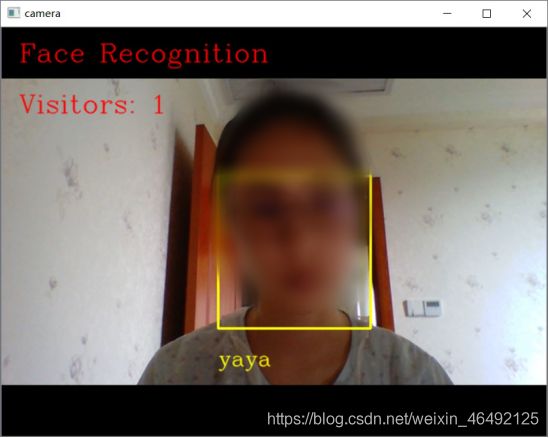
记录来访者,以时间和检测名命名的图片存储到文件visitor/known中,同时播放语音“欢迎光临!”。

(2)无法识别时
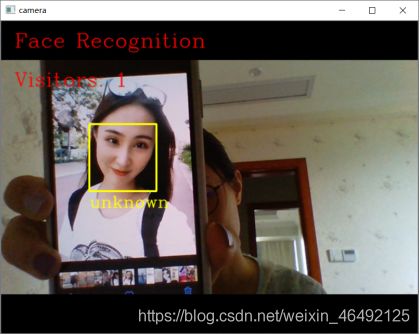
当遇见没在database中的人时,出现unknown标记,记录来访者,以时间和unknown命名的图片存储到文件visitor/unknown中,同时播放语音“抱歉,无法验证您的身份!”

注意:按下 q 键退出识别窗口!
参考博文:https://blog.csdn.net/cungudafa/article/details/93493229

